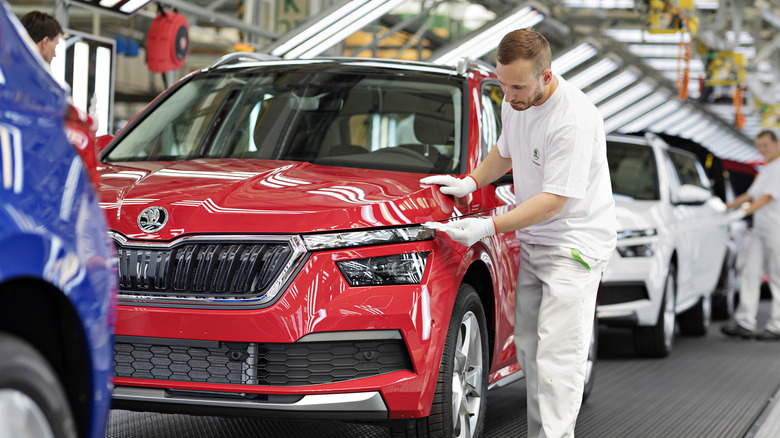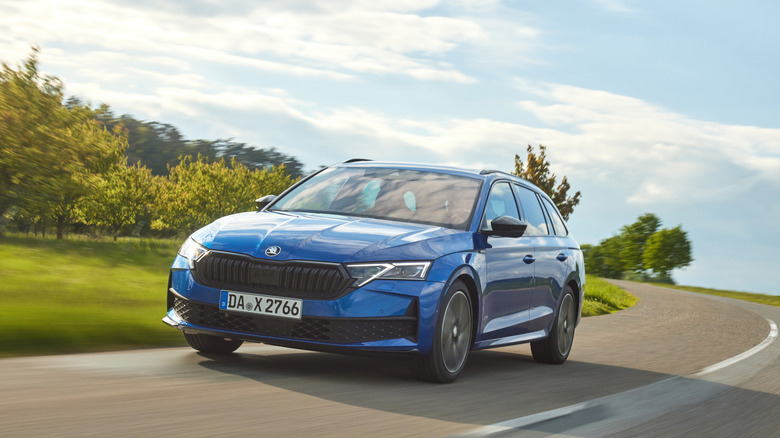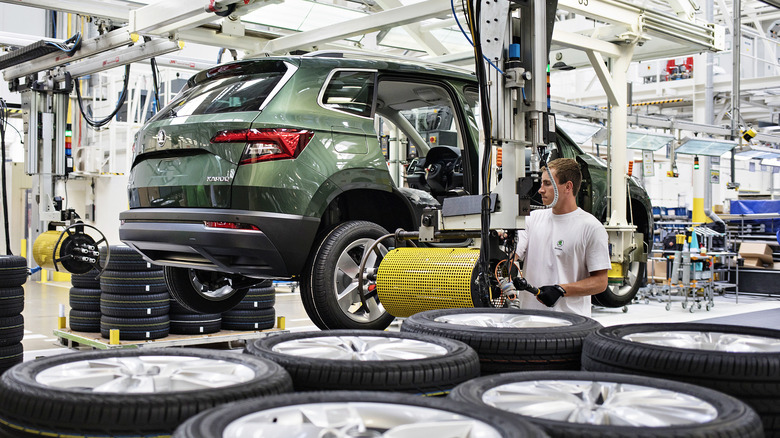Who Owns Škoda And Where Are The Cars Made?
As far as historically-significant automotive manufacturers go, not many Americans name Škoda among the top contenders, though the company has a long and proud history dating back to 1895. It was always a transportation-oriented firm, specializing in bicycles and motorcycles before branching off into automobiles and commercial ventures. Nowadays, Škoda is perhaps the Czech Republic's best-known premier automotive brand, widely regarded for its passenger cars, EVs, and more.
Škoda went through several company mergers over the years, going from a small firm named Laurin & Klement, owned by a pair of bicycle enthusiasts and mechanics, to merging with the original Škoda Works, a company specializing in arms and armor manufacturing, steam locomotives, and more. This became what we know today as Škoda, though its story doesn't stop there.
Much of the company's history was shaped by the Cold War, with Czechoslovakia going through a social and industrial revolution following the Fall of the Iron Curtain in 1989. The short answer is that Volkswagen purchased a stake in Škoda on December 9, 1990. Shares shifted hands as Volkswagen purchased more of the company before finally owning a 31-percent stake in April 1991, with Volkswagen assuming managerial control of Škoda. The German firm has retained ownership of Škoda ever since, one of many companies falling under the Volkswagen umbrella. As for production, Škoda assembles vehicles in a number of countries worldwide, namely: the Czech Republic, Slovakia, China, India, and Ukraine, all of which utilize Volkswagen-sourced components through its partnership.
How Škoda came under Volkswagen's ownership
Back in 1989, Czechoslovakia was known officially as the Czechoslovak Socialist Republic, one of the various satellite states of the Soviet Union. As such, Czechoslovakia featured a planned economy, though it also boasted a comparatively well-developed industrial base, which made it particularly well-suited to commercial production when the Iron Curtain came down. It was one of the Czechoslovak government's flagship industries, basically an industry that represented a core component of a country, like how Ford is to the United States, for example.
When the Iron Curtain fell, it left Czechoslovakia in search of private-state owners for its various firms, Škoda included. Volkswagen took to the plate here, and its reception was positively received by the Czechoslovak government, which was in negotiations with various carmakers. The government desired Škoda to continue as a primary exporter of indigenous goods throughout Europe, and saw such a deal as a means to not only fund its continued production and expansion, but likely also to help spread Škoda's influence beyond the country's borders.
The Czechoslovakian government, and by extension Škoda, underwent various modernizations to bring it more in line with contemporary tastes throughout the mid-late 1980s. Italian designer Nuccio Bertone, for instance, designed the Škoda Favorit. Meanwhile, Volkswagen supplied the means to expand the company, doubling its productivity by the mid-1990s. It became the fourth major manufacturer beneath the Volkswagen Auto Group's umbrella, producing vehicles like the Superb, one of many handsome sedans that are forbidden fruit to Americans.
Where are Škoda models produced?
Škoda owns plants in several countries, assembling approximately 925,000 cars annually and serving over a hundred different markets – though the U.S. isn't one of them, sadly. The vast majority of Škoda models are, in fact, still built in the native Czech Republic, utilizing two plants: Mladá Boleslav, which also serves as the company headquarters; and Kvasiny, which nowadays primarily specializes in SUVs such as the Karoq and Kodiaq.
The country with the most numerous plants is China, which houses four Škoda plants, namely: Yizheng (Rapid), Nanjing (Kamiq, Kamiq GT, and Superb), Ningbo (Octavia and Karoq), and Changsha (Kodiaq and Kodiaq GT). This ensures that the Chinese market, a notoriously demanding one for new cars, has enough production capacity to keep up with customer demand.
Lastly, we have the other nations: India, with two plants, and Slovakia and Ukraine, both with one plant. Russia used to house two plants as well, but the company has since ceased production due to the war in Ukraine. Uniquely, the Bratislava Slovak plant is the sole producer of the Citigo iV, the brand's first battery-powered city car, as well as Škoda's first true foray into EV territory. This plant actually belongs to Volkswagen, being the only plant belonging to Volkswagen Auto Group that produces vehicles for four different brands under one roof. Of course, the question of where all of Volkswagen's cars are made is an entirely different matter. Despite its diversity, however, Škoda largely retains its unique charms inherent to its rich history and status as a flagship manufacturer for the Czech Republic.


